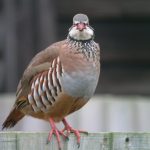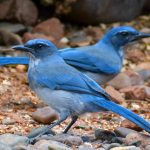It seems like Tennessee, Bay Breasted and Cape May Warblers are being reported a bit more often than usual this fall migration. I realized this when, on the same day that Will, Zack, and I found a Bay-breasted Warbler and a Tennessee Warbler in the same foraging flock at Vischer Ferry, my friend Tom found the same two species in Schoharie County. The three birds also seem to be popping up on birding listservs left and right. Tom, being a graduate of a forestry program, and therefore knowledgeable about both birds and trees, figured spruce budworm numbers had to be on the rise.
Why would more spruce budworms mean more of these three specific species of warbler? Well, according to page 151 of A Field Guide to Warblers of North America their populations are said to “fluctuate from year to year in response to fluctuations of spruce budworms, as in several ‘spruce-woods warblers'”.
And spruce budworms, as Tom guessed, are on the upswing. According to Natural Resources Canada outbreaks of the budworm occur about every 35 years and:
The last major outbreak of budworm in Atlantic Canada occurred in the late 1960s and early 1970s. Populations declined dramatically in the early 1980s, and only very low or endemic levels have been found since the late 1980s. Since then, many forestry staff have retired and many people now involved in forestry are unaware of the devastation this insect causes during a full blown outbreak. In addition, most control measures used during the last outbreak are no longer available. Pesticides in common use then, such as fenitrothion, are now restricted.
So the budworms are overdue, which means, as Tom told me, “if you’re a spruce budworm specialist you’ll be living large for the next few years, but if you have to go to Lowes to buy a 2×4 you will feel it in your wallet.”
But what exactly are spruce budworms and why are they bad for trees? According to a U.S Department of Agriculture pamphlet:
The spruce budworm Choristoneura fumiferana (Clemens) is one of the most destructive native insects in the northern spruce and fir forests of the Eastern United States and Canada. Periodic outbreaks of the spruce budworm are a part of the natural cycle of events associated with the maturing of balsam fir.The first recorded outbreak of the spruce budworm in the United States occurred in Maine about 1807. Another outbreak followed in 1878. Since 1909 there have been waves of budworm out breaks throughout the Eastern United States and Canada. The States most often affected are Maine, New Hampshire, New York, Michigan, Minnesota, and Wisconsin. These outbreaks have resulted in the loss of millions of cords of spruce and fir.
Balsam fir is the species most severely damaged by the bud-worm in the Eastern United States. White, red, and black spruce are suitable host trees and some feeding may occur on tamarack, pine, and hemlock. Spruce mixed with balsam fir is more likely to suffer budworm damage than spruce in pure stands…
The newly hatched budworm larva is very small and difficult to find because it bores into and feeds on needles or expanding buds. These larvae can cause severe damage to the expanding buds. As the larva grows, needles are severed at the base and left hanging in a thin silken web. The severed needles turn brown, giving the defoliated tree a scorched appearance. This condition is apparent from about mid-June until late August, depending on the weather and latitude.
So get out there and find those mixed foraging flocks of migrating warblers. The next couple of years might be the best opportunity to see these three spruce budworm dependent warblers in decent numbers for years to come.
And thanks to Tom for setting me up with the above links.













I have yet to see a Cape May Warbler this fall (only a very few days left…) but SE Michigan is just swarming with Tennessees right now and a few Bay-breasteds are also around.
There is another species that seems to be connected with Spruce Budworm and that is Evening Grosbeak. Evening Grosbeaks numbers peaked along with the bugs in the 1960’s and 70’s (with over 30,000 Evening Grosbeaks in New York State alone during one late 1970’s Christmas Bird Count season). However once the governments started spraying and spruce budworm decrease so has Evening Grosbeak, with less than 300 found on CBC’s in New York last year.
Does that mean that Evening Grosbeaks will respond as well? The largest flock I have ever had at my feeders (that I can remember, when I was a baby we used to have 50-100 every winter) was about 12 in May 1994, after one of the largest Redpoll and Siskin invasions ever.
Good stuff Corey!
@Jochen: Good luck and a safe flight back to Germany…see you in a month or so!
@Will: I did not know that.
@Patrick: Thanks!
Do you know what western bird species are associated with increased spruce bud worm populations?
@Teresa: I do not know. But I am sure some google searching would turn up an answer!
do you know why the spruce budworm outbreak in minnesota has been so bad?